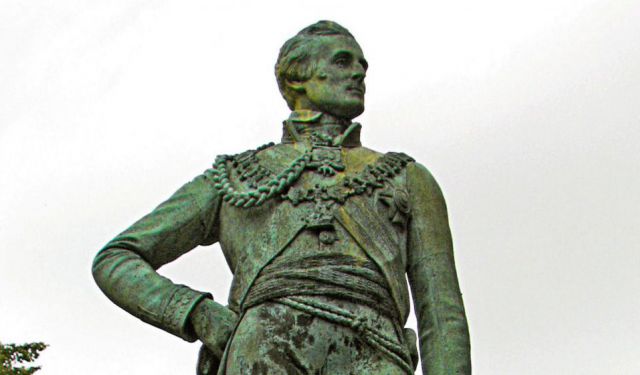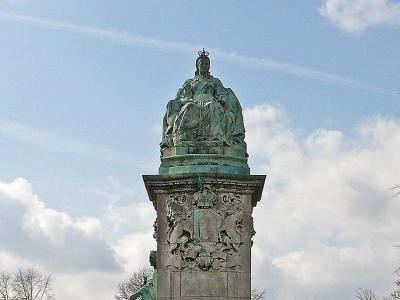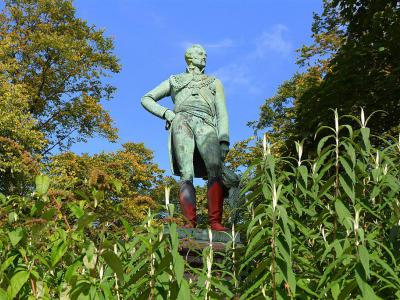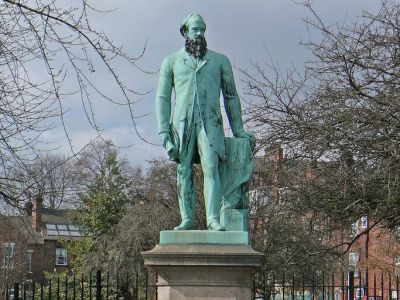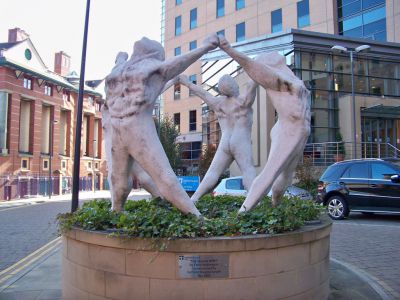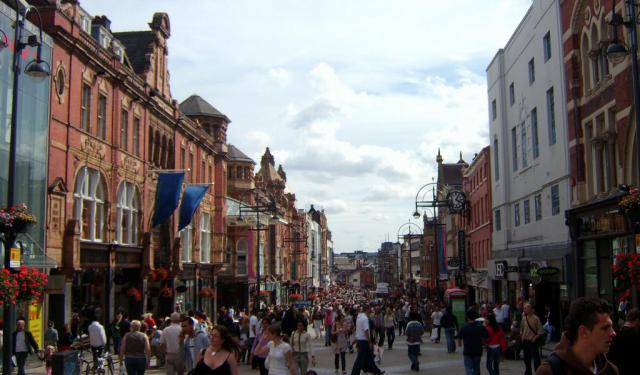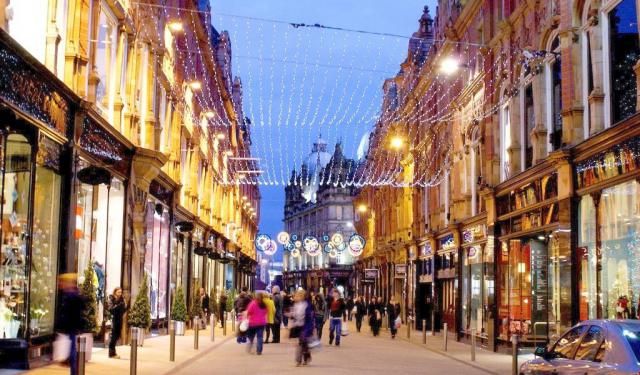Statues in Leeds Tour (Self Guided), Leeds
In Leeds, statues adorn various corners, reflecting historical figures and cultural symbols. Some of them are hundreds of years old but still in remarkable condition.
One notable sculpture is that of Robert Peel, commemorating the 19th-century Prime Minister and founder of Britain's modern police force.
On the opposite side of the nearby Woodhouse Moor Park stands the regal Statue of Queen Victoria. Crafted in 1905, it depicts Britain's iconic monarch whose reign, the Victorian era, symbolized a period of stability and progress.
Another corner of the same park is marked by the Duke of Wellington Statue, paying homage to the military prowess of the renowned British general.
Further along, the Sir Peter Fairbairn Statue honors the former Mayor of Leeds, reflecting his significant contributions as an industrialist and civic leader.
The Human Spirit sculpture outside Nuffield Hospital, installed in 2002, portrays four interconnected figures symbolizing unity, sparking curiosity and speculation among passersby about its deeper meaning.
Meanwhile, the Petanque Statue, located in the bustling Bond Court square, adds a touch of whimsy, featuring bronze figures engaged in the traditional English bowl game.
Lastly, the equestrian Black Prince Statue stands tall, commemorating a significant historical figure and offering a glimpse into the region's medieval past.
Each of these statues contributes to the colorful tapestry of Leeds' history and identity, inviting visitors to explore and reflect on the city's heritage. So, when in Leeds, it's always a good idea to take a moment to appreciate these statues and the stories they tell. Either by taking this self-guided walk or simply passing by, just pause to acknowledge the individuals and events they represent to deepen our connection to the city's history and culture.
One notable sculpture is that of Robert Peel, commemorating the 19th-century Prime Minister and founder of Britain's modern police force.
On the opposite side of the nearby Woodhouse Moor Park stands the regal Statue of Queen Victoria. Crafted in 1905, it depicts Britain's iconic monarch whose reign, the Victorian era, symbolized a period of stability and progress.
Another corner of the same park is marked by the Duke of Wellington Statue, paying homage to the military prowess of the renowned British general.
Further along, the Sir Peter Fairbairn Statue honors the former Mayor of Leeds, reflecting his significant contributions as an industrialist and civic leader.
The Human Spirit sculpture outside Nuffield Hospital, installed in 2002, portrays four interconnected figures symbolizing unity, sparking curiosity and speculation among passersby about its deeper meaning.
Meanwhile, the Petanque Statue, located in the bustling Bond Court square, adds a touch of whimsy, featuring bronze figures engaged in the traditional English bowl game.
Lastly, the equestrian Black Prince Statue stands tall, commemorating a significant historical figure and offering a glimpse into the region's medieval past.
Each of these statues contributes to the colorful tapestry of Leeds' history and identity, inviting visitors to explore and reflect on the city's heritage. So, when in Leeds, it's always a good idea to take a moment to appreciate these statues and the stories they tell. Either by taking this self-guided walk or simply passing by, just pause to acknowledge the individuals and events they represent to deepen our connection to the city's history and culture.
How it works: Download the app "GPSmyCity: Walks in 1K+ Cities" from Apple App Store or Google Play Store to your mobile phone or tablet. The app turns your mobile device into a personal tour guide and its built-in GPS navigation functions guide you from one tour stop to next. The app works offline, so no data plan is needed when traveling abroad.
Statues in Leeds Tour Map
Guide Name: Statues in Leeds Tour
Guide Location: England » Leeds (See other walking tours in Leeds)
Guide Type: Self-guided Walking Tour (Sightseeing)
# of Attractions: 7
Tour Duration: 2 Hour(s)
Travel Distance: 3.2 Km or 2 Miles
Author: sabrina
Sight(s) Featured in This Guide:
Guide Location: England » Leeds (See other walking tours in Leeds)
Guide Type: Self-guided Walking Tour (Sightseeing)
# of Attractions: 7
Tour Duration: 2 Hour(s)
Travel Distance: 3.2 Km or 2 Miles
Author: sabrina
Sight(s) Featured in This Guide:
- Robert Peel Statue
- Statue of Queen Victoria
- The Duke of Wellington Statue
- Sir Peter Fairbairn Statue
- The Human Spirit Statue
- Petanque Statue
- The Black Prince Statue
1) Robert Peel Statue
The Robert Peel Statue in Leeds stands as a tribute to one of Britain’s most influential 19th-century statesmen. Sir Robert Peel, twice Prime Minister of the United Kingdom (1834–35, 1841–46), is celebrated for his role in establishing modern policing, giving rise to the iconic term “bobbies.” During his tenure as Home Secretary (1822–27, 1828–30), Peel introduced significant reforms, including the creation of the Metropolitan Police Force in 1829. He also played a key role in Roman Catholic emancipation and repealed the Corn Laws, a move that ultimately cost him his political office but underscored his commitment to national welfare. His untimely death in 1850 deeply moved the nation, sparking widespread grief.
Shortly after his passing, the people of Leeds initiated efforts to honor Peel with a public statue. A committee was formed, and a competition was held, with sculptor William Behnes securing the commission. While some suggested an antique-style depiction of Peel in a toga, the Leeds Town Council opted for a more contemporary representation, reflecting his role as a statesman. The result was an imposing bronze figure, 8 feet 6 inches tall, cast by F. Robinson of the Statue Foundry in Pimlico, London. Notably, it was the first large statue in Britain to be cast in a single piece.
The statue, featuring Peel in modern attire and addressing the House of Commons, was initially installed in front of the Post Office on Park Row. It was unveiled on August 20, 1852, in a grand ceremony attended by a large crowd. Over the years, it found new homes: Victoria Square in the 1890s, then Woodhouse Moor in 1937, where it remains today. The statue, mounted on a pedestal of Scottish granite, continues to commemorate Peel’s legacy as a reformer and public servant who shaped modern Britain.
Shortly after his passing, the people of Leeds initiated efforts to honor Peel with a public statue. A committee was formed, and a competition was held, with sculptor William Behnes securing the commission. While some suggested an antique-style depiction of Peel in a toga, the Leeds Town Council opted for a more contemporary representation, reflecting his role as a statesman. The result was an imposing bronze figure, 8 feet 6 inches tall, cast by F. Robinson of the Statue Foundry in Pimlico, London. Notably, it was the first large statue in Britain to be cast in a single piece.
The statue, featuring Peel in modern attire and addressing the House of Commons, was initially installed in front of the Post Office on Park Row. It was unveiled on August 20, 1852, in a grand ceremony attended by a large crowd. Over the years, it found new homes: Victoria Square in the 1890s, then Woodhouse Moor in 1937, where it remains today. The statue, mounted on a pedestal of Scottish granite, continues to commemorate Peel’s legacy as a reformer and public servant who shaped modern Britain.
2) Statue of Queen Victoria
The Statue of Queen Victoria in Leeds is a striking memorial located in Woodhouse Moor, where it has stood since 1937 after being relocated from its original site outside Leeds Town Hall. Unveiled on 27 November 1905, the statue is the work of sculptor Sir George Frampton and architect Leonard Stokes, and it serves as a tribute to Queen Victoria and the imperial legacy of her era.
The centerpiece of the memorial is a bronze figure of Queen Victoria seated on a throne, with a scepter resting on her right forearm and an orb in her left hand. The throne’s back features a design resembling a radiant sun, symbolizing power and authority. Flanking the Portland stone pedestal are allegorical bronze figures: Peace, represented on the left, and Industry, on the right. The pedestal is further adorned with intricate details, including the Royal Arms, the Leeds coat of arms, and an inscription on the reverse.
A continuous frieze on the lower plinth celebrates the extent of the British Empire during Victoria’s reign, featuring the words "INDIA," "AUSTRALIA," "CANADA," and "AFRICA", framed by motifs of owls and foliage. The entire structure rests on a series of four steps, adding grandeur to its presence in the park.
Designated as a Grade II listed building* on 5 August 1976, the memorial has undergone several restoration efforts to address vandalism and environmental damage, including the conservation and refixing of the Industry figure and the removal of graffiti. Despite these efforts, the statue continues to require further conservation to preserve its historical and artistic significance.
The centerpiece of the memorial is a bronze figure of Queen Victoria seated on a throne, with a scepter resting on her right forearm and an orb in her left hand. The throne’s back features a design resembling a radiant sun, symbolizing power and authority. Flanking the Portland stone pedestal are allegorical bronze figures: Peace, represented on the left, and Industry, on the right. The pedestal is further adorned with intricate details, including the Royal Arms, the Leeds coat of arms, and an inscription on the reverse.
A continuous frieze on the lower plinth celebrates the extent of the British Empire during Victoria’s reign, featuring the words "INDIA," "AUSTRALIA," "CANADA," and "AFRICA", framed by motifs of owls and foliage. The entire structure rests on a series of four steps, adding grandeur to its presence in the park.
Designated as a Grade II listed building* on 5 August 1976, the memorial has undergone several restoration efforts to address vandalism and environmental damage, including the conservation and refixing of the Industry figure and the removal of graffiti. Despite these efforts, the statue continues to require further conservation to preserve its historical and artistic significance.
3) The Duke of Wellington Statue
The Duke of Wellington Statue in Leeds is a bronze monument sculpted by Baron Carlo Marochetti, one of Queen Victoria's favorite sculptors, and was completed in 1855. Originally installed in Victoria Square, in front of Leeds Town Hall, the statue was relocated to Woodhouse Moor Park in 1937 due to the reconfiguration of the square.
The statue depicts Arthur Wellesley, the First Duke of Wellington, a celebrated 19th-century military and political leader known for his role in the Napoleonic Wars and as a two-time British Prime Minister. Dressed in formal attire with his iconic Wellington boots, the Duke stands confidently, his right hand resting on his hip while holding a plumed feather hat in his left hand. The statue showcases the sculptor’s characteristic flair, although Marochetti's style was sometimes criticized for being overly elaborate.
Despite its historical significance, the statue’s current placement in the green space of Woodhouse Moor has sparked mixed reactions. Its height and surrounding vegetation make it somewhat difficult to appreciate fully. Located near the University of Leeds, the statue has also become a target for student traditions, with the Duke’s boots frequently painted red-adding a touch of irreverence to its dignified stance.
Commissioned in honor of the Duke’s death in 1852, the statue was funded by £1,500 raised by the citizens of Leeds. Its creation was not without controversy; Marochetti’s Sardinian heritage led some to question the choice of a foreign sculptor for such an eminent British figure. Nonetheless, the statue was unveiled in 1858, coinciding with the opening of Leeds Town Hall by Queen Victoria. Today, it stands as both a tribute to Wellington’s legacy and a quirky symbol of local student culture.
The statue depicts Arthur Wellesley, the First Duke of Wellington, a celebrated 19th-century military and political leader known for his role in the Napoleonic Wars and as a two-time British Prime Minister. Dressed in formal attire with his iconic Wellington boots, the Duke stands confidently, his right hand resting on his hip while holding a plumed feather hat in his left hand. The statue showcases the sculptor’s characteristic flair, although Marochetti's style was sometimes criticized for being overly elaborate.
Despite its historical significance, the statue’s current placement in the green space of Woodhouse Moor has sparked mixed reactions. Its height and surrounding vegetation make it somewhat difficult to appreciate fully. Located near the University of Leeds, the statue has also become a target for student traditions, with the Duke’s boots frequently painted red-adding a touch of irreverence to its dignified stance.
Commissioned in honor of the Duke’s death in 1852, the statue was funded by £1,500 raised by the citizens of Leeds. Its creation was not without controversy; Marochetti’s Sardinian heritage led some to question the choice of a foreign sculptor for such an eminent British figure. Nonetheless, the statue was unveiled in 1858, coinciding with the opening of Leeds Town Hall by Queen Victoria. Today, it stands as both a tribute to Wellington’s legacy and a quirky symbol of local student culture.
4) Sir Peter Fairbairn Statue
The statue of Sir Peter Fairbairn, crafted by renowned sculptor Matthew Noble in 1868, stands proudly in Woodhouse Square, Leeds, commemorating the legacy of a significant figure in the city’s history. Sir Peter Fairbairn (1799–1864), originally from Scotland, arrived in Leeds in 1828 after spending his early years in Newcastle. A talented engineer and inventor, he established the Wellington Foundry, which specialized in machinery for the woolen industry, playing a key role in the region’s industrial development.
Fairbairn’s public service began with his election to the Leeds Town Council in 1836, where he served until 1842. By 1854, he had become an alderman and magistrate, culminating in his tenure as mayor from 1857 to 1859. During this time, he hosted Queen Victoria and Prince Albert for the grand opening of Leeds Town Hall in 1858, a landmark event that earned him a knighthood for his distinguished contributions.
Beyond his professional and political achievements, Fairbairn demonstrated a commitment to improving the lives of his workers, notably forming one of the largest brass bands in the region to provide them with recreational opportunities. His dedication to both industry and public service left an indelible mark on Leeds.
The nearly 150-year-old statue remains a testament to his influence, a reminder of a time when innovation and civic duty shaped the city’s future. Visitors and history enthusiasts alike can find inspiration in this enduring tribute to one of Leeds’ most notable figures.
Fairbairn’s public service began with his election to the Leeds Town Council in 1836, where he served until 1842. By 1854, he had become an alderman and magistrate, culminating in his tenure as mayor from 1857 to 1859. During this time, he hosted Queen Victoria and Prince Albert for the grand opening of Leeds Town Hall in 1858, a landmark event that earned him a knighthood for his distinguished contributions.
Beyond his professional and political achievements, Fairbairn demonstrated a commitment to improving the lives of his workers, notably forming one of the largest brass bands in the region to provide them with recreational opportunities. His dedication to both industry and public service left an indelible mark on Leeds.
The nearly 150-year-old statue remains a testament to his influence, a reminder of a time when innovation and civic duty shaped the city’s future. Visitors and history enthusiasts alike can find inspiration in this enduring tribute to one of Leeds’ most notable figures.
5) The Human Spirit Statue
Situated prominently outside the Nuffield Hospital in Leeds, The Human Spirit is a striking sculpture created by Faith Bebbington in 2002. Originally titled Crown by the artist, the piece was renamed by the hospital, which commissioned it to commemorate its opening. This thought-provoking work consists of four androgynous human figures leaning outward in a circle, their linked forms symbolizing unity, support, and the resilience of the human spirit. The figures stand on a circular brick base, echoing the geometric inspirations behind the sculpture.
Faith Bebbington drew inspiration from Leonardo da Vinci’s Vitruvian Man, incorporating the concept of ideal proportions and harmony. The hospital specifically sought a bold, impactful piece to embody themes of health and vitality. True to Bebbington’s artistic style, the sculpture exudes movement and theatricality, with its figures appearing balanced precariously, emphasizing themes of connection and mutual reliance.
Despite its symbolic strength, The Human Spirit has garnered attention for more than its visual appeal. A plaque at the statue’s base, intended to honor the artist and the work, mistakenly spells Bebbington’s name as “Babbington,” adding an ironic touch to the history of this otherwise carefully crafted piece.
Today, the statue continues to captivate passersby, sparking diverse interpretations of its deeper meaning while serving as a testament to the enduring power of human connection.
Faith Bebbington drew inspiration from Leonardo da Vinci’s Vitruvian Man, incorporating the concept of ideal proportions and harmony. The hospital specifically sought a bold, impactful piece to embody themes of health and vitality. True to Bebbington’s artistic style, the sculpture exudes movement and theatricality, with its figures appearing balanced precariously, emphasizing themes of connection and mutual reliance.
Despite its symbolic strength, The Human Spirit has garnered attention for more than its visual appeal. A plaque at the statue’s base, intended to honor the artist and the work, mistakenly spells Bebbington’s name as “Babbington,” adding an ironic touch to the history of this otherwise carefully crafted piece.
Today, the statue continues to captivate passersby, sparking diverse interpretations of its deeper meaning while serving as a testament to the enduring power of human connection.
6) Petanque Statue
The Petanque Statue, officially known as The Boules Players, is a striking bronze sculpture located in Bond Court, a popular square in central Leeds. Created by renowned sculptor Roger Burnett, the artwork captures the charm of the traditional French game of pétanque (or boules) and celebrates the cultural connection between Leeds and its twin city, Lille, France.
Unveiled in 2000 by the Lord Mayor of Lille, the sculpture was commissioned to mark the annual Northern Pétanque Colliers CRE Cup, a tournament that began in 1998. The life-sized figures depict a quintessential French pétanque player mid-throw, observed with curiosity by a Yorkshire family of three-a man, a woman, and their child. This dynamic interplay between the French and Yorkshire traditions reflects the sculpture's celebration of cultural exchange and unity.
Roger Burnett, who hails from Sowerby Bridge, faced creative challenges in designing the family. In his diary, he humorously recounted the extensive process of arranging the figures, experimenting with positions until the final composition-a couple with a child-was achieved. Nearby, a real pétanque court complements the artwork, inviting locals to engage with the game. An information board provides the rules, making the site as educational as it is artistic.
Bond Court has since become a hub for pétanque enthusiasts, with the court hosting lunchtime tournaments and summer championships. The sculpture itself remains a curious and interactive feature, blending history, sport, and art in the heart of Leeds’ bustling banking district. For those intrigued by Burnett’s work, a similar sculpture by the artist can be found near his studio at Sowerby Bridge.
Unveiled in 2000 by the Lord Mayor of Lille, the sculpture was commissioned to mark the annual Northern Pétanque Colliers CRE Cup, a tournament that began in 1998. The life-sized figures depict a quintessential French pétanque player mid-throw, observed with curiosity by a Yorkshire family of three-a man, a woman, and their child. This dynamic interplay between the French and Yorkshire traditions reflects the sculpture's celebration of cultural exchange and unity.
Roger Burnett, who hails from Sowerby Bridge, faced creative challenges in designing the family. In his diary, he humorously recounted the extensive process of arranging the figures, experimenting with positions until the final composition-a couple with a child-was achieved. Nearby, a real pétanque court complements the artwork, inviting locals to engage with the game. An information board provides the rules, making the site as educational as it is artistic.
Bond Court has since become a hub for pétanque enthusiasts, with the court hosting lunchtime tournaments and summer championships. The sculpture itself remains a curious and interactive feature, blending history, sport, and art in the heart of Leeds’ bustling banking district. For those intrigued by Burnett’s work, a similar sculpture by the artist can be found near his studio at Sowerby Bridge.
7) The Black Prince Statue
Prominently situated in Leeds' City Square, The Black Prince Statue is a striking bronze monument that celebrates Edward of Woodstock, better known as the Black Prince. Though he had no direct connection to Leeds, his legendary status as a military commander and his embodiment of civic virtues earned him this prominent placement. The statue was unveiled on September 16, 1903, and has since become one of the city’s most recognizable landmarks.
Edward of Woodstock, the eldest son of King Edward III, was a pivotal figure in the Hundred Years’ War. Known for his tactical brilliance, his victory at the Battle of Poitiers in 1356 forced France to pay an extraordinary ransom, altering the course of the war. Despite his significant achievements, Edward never ascended the English throne, as he predeceased his father in 1376.
The nickname "Black Prince" is believed to have originated posthumously, either due to his black armor or English propaganda emphasizing his fearsome reputation. Sculpted by Thomas Brock, who also created the Victoria Memorial outside Buckingham Palace, the statue took seven years to complete. It was forged in Belgium, as Britain lacked a forge large enough for the task, and was transported to Leeds via canal barge.
The statue portrays Edward mounted on horseback, clad in armor, with his sword raised in a heroic pose. The plinth features lion heads, symbolizing strength and nobility. Surrounding the statue are eight lamp bearers designed by Sir Alfred Drury, representing different times of the day. These lamp bearers sparked controversy when first unveiled due to the way the women were depicted.
The Black Prince Statue is more than just a monument to a historical figure; it reflects the aspirations and values of Leeds during its transformation into a modern city. The statue stands amidst other architectural treasures in City Square, making it a popular destination for tourists and history enthusiasts. Today, it serves as a symbol of Leeds’ rich heritage and a reminder of timeless virtues such as bravery, leadership, and duty.
Edward of Woodstock, the eldest son of King Edward III, was a pivotal figure in the Hundred Years’ War. Known for his tactical brilliance, his victory at the Battle of Poitiers in 1356 forced France to pay an extraordinary ransom, altering the course of the war. Despite his significant achievements, Edward never ascended the English throne, as he predeceased his father in 1376.
The nickname "Black Prince" is believed to have originated posthumously, either due to his black armor or English propaganda emphasizing his fearsome reputation. Sculpted by Thomas Brock, who also created the Victoria Memorial outside Buckingham Palace, the statue took seven years to complete. It was forged in Belgium, as Britain lacked a forge large enough for the task, and was transported to Leeds via canal barge.
The statue portrays Edward mounted on horseback, clad in armor, with his sword raised in a heroic pose. The plinth features lion heads, symbolizing strength and nobility. Surrounding the statue are eight lamp bearers designed by Sir Alfred Drury, representing different times of the day. These lamp bearers sparked controversy when first unveiled due to the way the women were depicted.
The Black Prince Statue is more than just a monument to a historical figure; it reflects the aspirations and values of Leeds during its transformation into a modern city. The statue stands amidst other architectural treasures in City Square, making it a popular destination for tourists and history enthusiasts. Today, it serves as a symbol of Leeds’ rich heritage and a reminder of timeless virtues such as bravery, leadership, and duty.
Walking Tours in Leeds, England
Create Your Own Walk in Leeds
Creating your own self-guided walk in Leeds is easy and fun. Choose the city attractions that you want to see and a walk route map will be created just for you. You can even set your hotel as the start point of the walk.
Leeds Introduction Walking Tour
The old Brythonic word "Ladenses" meant "folks of the rapid river." The river was the River Aire that flows through the City of Leeds today. In the 5th century the once forested area of Leeds was part of the Brythonic kingdom of Elmet. The Venerable Bede called it "Loidis." In Welsh it was "lloed", "a place." At any rate, "Leeds."
The... view more
Tour Duration: 2 Hour(s)
Travel Distance: 2.7 Km or 1.7 Miles
The... view more
Tour Duration: 2 Hour(s)
Travel Distance: 2.7 Km or 1.7 Miles
Historical Shopping Venues Tour
Leeds is a shopaholic’s paradise and a true world of retail scaled down to the size of a downtown area. Compactly located within a walking distance from each other, the city's best boutiques are never far away from an eager shopper.
Here, the biggest brands and small independents are housed in some of the city’s most iconic buildings. Among them is the historic Kirkgate Market, the... view more
Tour Duration: 1 Hour(s)
Travel Distance: 1.2 Km or 0.7 Miles
Here, the biggest brands and small independents are housed in some of the city’s most iconic buildings. Among them is the historic Kirkgate Market, the... view more
Tour Duration: 1 Hour(s)
Travel Distance: 1.2 Km or 0.7 Miles
The Most Popular Cities
/ view all
